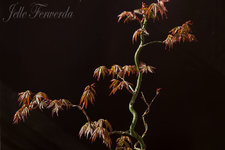Just to be clear, I fully agree with everything you have been saying, but for the sake of adding to the nerdy-twist this thread is taking, here is something to consider:
You are right that propagation via cuttings (or grafts) preserves the DNA sequence and therefore there are no changes in genotype.
However, we know that epigenetic factors can alter gene expression and can lead to changes in phenotype without any change in genotype, meaning Deshojo cuttings may LOOK different despite being genetically identical.
So this actually supports the position that you (and I) have taken here: it’s wreckless to try to identify a ‘cultivar’ (i.e. its genotype) on the basis of appearance.
Whether phenotypic changes are heritable is a much more complicated question when it comes to Acer palmatum (in general, they can be inherited, but i have not seen this proven with Japanese Maples). Can changes in phenotype (without change in genotype/DNA) be inherited and preserved via cutting/grafting? Or is there a return to the ‘common’ genetic expression and phenotype if/when the epigenetic factors alter or disappear?
There is potentially an argument to be made that the artificial selection process can be applied at the level of phenotype via cutting propagation.
I know with certainty that the Deshojo that i imported from Japan recently have smaller leaves and shorter internodes than the Deshojo in my yard that was imported 25 years ago, and the Deshojo that i purchased at the landscape store.
This spring I will be taking cuttings of each of these ‘groups’, and will be treating them exactly the same. After a few years of identical treatment, will they look the same? At this point i don’t know.
But i’m no expert in this stuff, just a casual reader who is speculating from first principles
@Owen Reich any thoughts?

